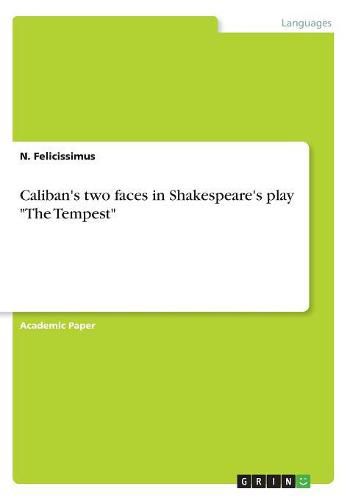Readings Newsletter
Become a Readings Member to make your shopping experience even easier.
Sign in or sign up for free!
You’re not far away from qualifying for FREE standard shipping within Australia
You’ve qualified for FREE standard shipping within Australia
The cart is loading…






Academic Paper from the year 2016 in the subject English - Literature, Works, grade: 1,7, University of Wurzburg, language: English, abstract: A savage and deformed slave. Shakespeare uses exactly these words to describe the figure of Caliban in the dramatis personae of his play The Tempest . For almost four centuries, literary critics have dealt with trying to answer the question how Shakespeare’s character has to be regarded. Is Caliban to be considered as a monster representing humanity’s bestial side including all its vices, and thereby arousing the audience’s disgust? Or has he rather to be looked at as the victim of an imperial tyrant - personified by Prospero - who arouses the spectator’s pity? Among Shakespeare’s stage characters, Caliban has been interpreted in many different ways. He has been represented in theatre and in literary criticism as a fish, a tortoise, an American Indian, and an African slave. He is said to be one of the most abstract and wildest characters in Shakespeare’s plays.
$9.00 standard shipping within Australia
FREE standard shipping within Australia for orders over $100.00
Express & International shipping calculated at checkout
Academic Paper from the year 2016 in the subject English - Literature, Works, grade: 1,7, University of Wurzburg, language: English, abstract: A savage and deformed slave. Shakespeare uses exactly these words to describe the figure of Caliban in the dramatis personae of his play The Tempest . For almost four centuries, literary critics have dealt with trying to answer the question how Shakespeare’s character has to be regarded. Is Caliban to be considered as a monster representing humanity’s bestial side including all its vices, and thereby arousing the audience’s disgust? Or has he rather to be looked at as the victim of an imperial tyrant - personified by Prospero - who arouses the spectator’s pity? Among Shakespeare’s stage characters, Caliban has been interpreted in many different ways. He has been represented in theatre and in literary criticism as a fish, a tortoise, an American Indian, and an African slave. He is said to be one of the most abstract and wildest characters in Shakespeare’s plays.